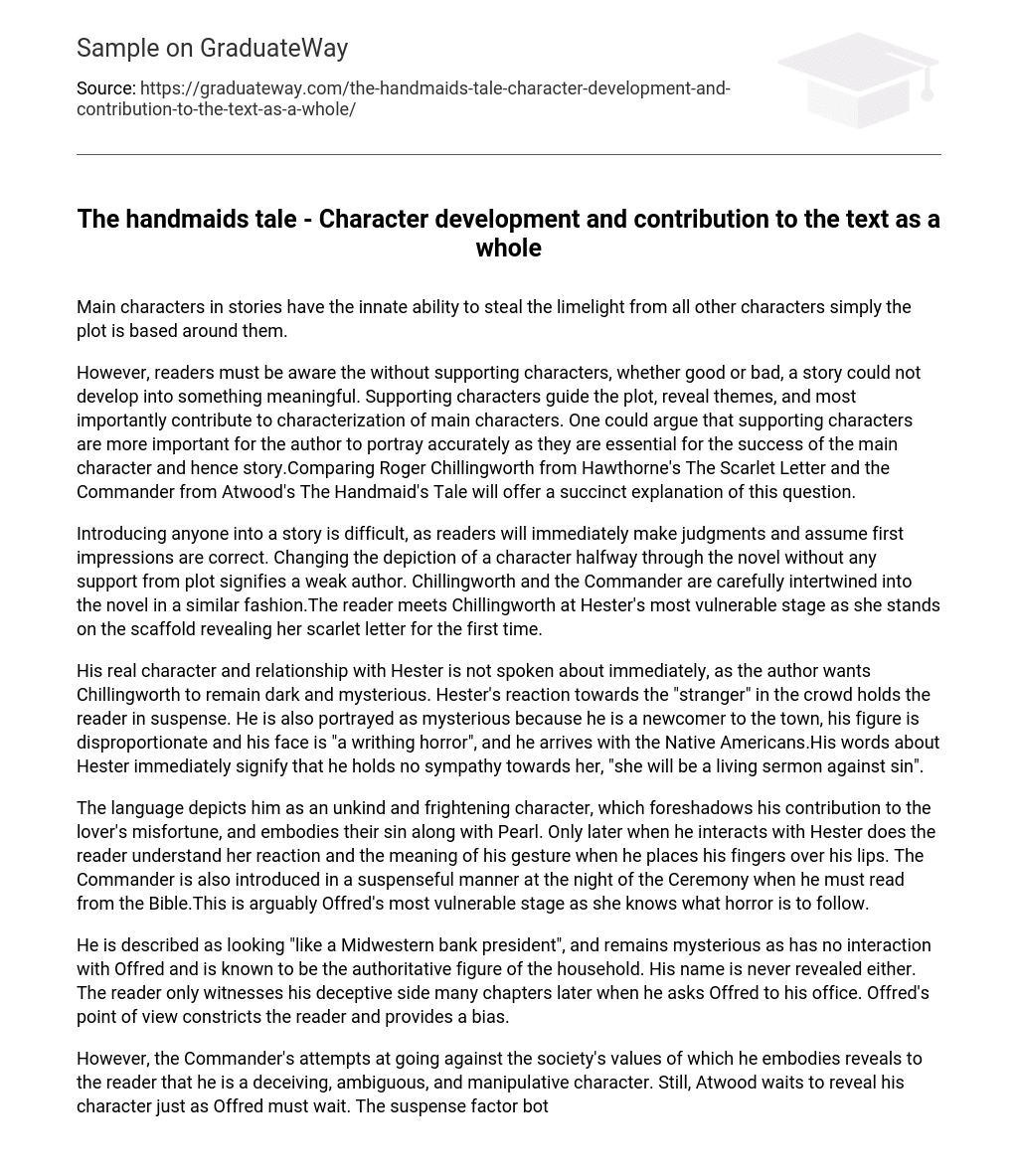The plot of stories revolves around main characters, who have the inherent ability to attract attention from other characters.
The significance of supporting characters in a story cannot be overlooked. They are vital for the development of a meaningful plot, as well as for revealing themes and shaping the main characters. The portrayal of supporting characters is particularly crucial for authors, as they contribute to the success of the main character and ultimately the entire story. Comparing Roger Chillingworth from Hawthorne’s The Scarlet Letter and the Commander from Atwood’s The Handmaid’s Tale provides valuable insights into this matter.
Introducing a character into a story is challenging because readers tend to judge and form opinions based on first impressions. If an author suddenly changes the depiction of a character in the middle of a novel without any support from the plot, it reflects poorly on their skill. In this regard, Chillingworth and the Commander are seamlessly woven into the novel. When we encounter Chillingworth, it is during Hester’s most vulnerable moment – standing on the scaffold and revealing her scarlet letter for the first time.
The author intentionally withholds immediate information about Chillingworth’s true character and relationship with Hester in order to maintain a sense of darkness and mystery surrounding him. Hester’s reaction to the unfamiliar figure in the crowd builds suspense for the reader. Chillingworth is further depicted as enigmatic due to his status as a newcomer to the town, his physical appearance that is out of proportion, and his face that is described as a “writhing horror.” Additionally, his arrival with the Native Americans adds to his mysterious persona. His words regarding Hester indicate a lack of sympathy towards her, suggesting that she will serve as a living example of sin.
The language used to describe him portrays him as an uncaring and terrifying person, which hints at his role in the lover’s downfall and represents their shared guilt with Pearl. It is only when he interacts with Hester that the reader comprehends her response and the significance behind his action of placing his fingers over his mouth. The Commander is also introduced in a tense manner during the evening of the Ceremony when he must recite from the Bible. This can be considered Offred’s most fragile state as she is aware of the impending horror.
He is often referred to as resembling a Midwestern bank president and retains an air of mystery as he never interacts with Offred. It is understood that he holds a position of authority within the household, although his name is never disclosed. The true extent of his duplicitous nature is only revealed several chapters later when he invites Offred to his office. The limited perspective through Offred’s eyes narrows the reader’s understanding and creates a biased viewpoint.
Although the Commander’s actions defy the values of the society he represents, the reader eventually discovers that he is a deceptive and manipulative character. Atwood withholds his true nature, as Offred also waits to uncover it. Both authors create suspense around these supporting male characters, hinting at their significance to the theme and plot. Chillingworth and the Commander have comparable roles and share many similarities as characters.
Both characters have authority over the vulnerable female protagonist, presenting a contrast between purity and moral corruption. Their physical appearance mirrors their psychological state. For instance, as Chillingworth becomes increasingly bitter, satanic, and closer to the truth, his appearance worsens, becoming more deformed and frail. Hawthorne may be suggesting that their supposed sinful love possesses a powerful force, which is actually an innate part of nature that should not be obstructed.
The text suggests that Hawthorne’s true feelings towards the sin of the lovers are not fully understood. Additionally, it points out that while Chillingworth is seen as a healer for the Puritan society, he actually harms Dimmesdale’s health, revealing a duplicitous nature. Referring back to the comparison of the Commander to a “Midwestern bank manager,” this could imply that his outwardly law-abiding appearance contradicts his deceptive and ambiguous demeanor. It implies that a bank manager may not be deemed trustworthy.
Thus, the Commander serves as a symbol of corruption and deceit in Atwood’s dystopian novel, embodying the traits of an authoritative figure within this totalitarian society. The presence of duplicity further emphasizes the Commander’s character. Consequently, male characters in the story are utilized by the authors to portray the evil prevailing in society, utilizing their power to exert control over the main female protagonists who potentially possess heroic qualities. The clandestine nature of both Chillingworth and Hester’s relationship and the Commander and Offred’s relationship gives rise to the peak of tension in both novels.
Chillingworth, who is aware of Dimmesdale’s and Hester’s secret, is responsible for its eventual exposure to the public. This ultimately becomes the turning point in the novel. Additionally, the clandestine encounters between Offred and the Commander play a significant role in her escape as she gains more knowledge about him, growing stronger in the process. These detested characters also enable readers to assign blame for the unfortunate circumstances faced by the female characters.
The responsibility for the main character’s despair should not be attributed to society. Instead, the reader can identify one individual who interacts with the main character the most and contributes significantly to their suffering. Regardless of how disliked a character may be, their presence serves a crucial purpose. Supporting characters hold equal significance in a novel as the main ones and should not be overlooked. Without these ruthless characters, the narratives of both The Handmaid’s Tale and The Scarlet Letter would undergo significant changes.
Society alone cannot embody the malevolent character needed to juxtapose the virtue depicted in a novel. It is noteworthy that the remarkable resemblances between Chillingworth and the Commander are also evident in the fact that both roles are portrayed by the same actor in the film adaptations.





